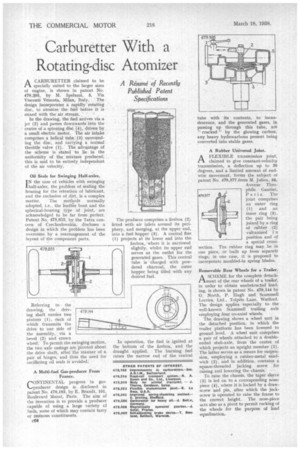Carburetter With a Rotating-disc Atomizer
Page 102

If you've noticed an error in this article please click here to report it so we can fix it.
A Resume of Recently Published Patent Specifications
ACARBURETTER claimed to be specially suited to the larger sizes of engine, is shown in patent No. 479,395, by M. Speluzzi, 5, Via Visconti Venosta, Milan, Italy. The design incorporates a rapidly -rotating disc, to atomize the fuel before it is mixed with the air stream.
In the drawing, the fuel arrives via a jet (2) and passes downwards into the • centre of a spinning disc (4), driven by a small electric Motor. The air intake comprises a helical tube (3) surrounding the disc, and carrying a normal throttle valve (1). The advantage of the scheme is stated to lie in the uniformity of the. mixture produced; this is said to be entirely independent of the air velocity.
Oil Seals for Swinging Half-axles. I N the case of vehicles with swinging half-axles, the problem of sealing the housing for the retention of lubricant, and the exclusion of dirt, is a complex matter. The methods normally adopted, i.e., the leather boot and the spherical-housing type of joint, are acknowledged to be far from perfect. Patent No. 478,833, by the Tatra concern of Czechoslovakia, discloses a design in which the problem has been overcome by a rearrangement of the layout of the component parts.
Referring to the drawing, the driving shaft carries two pinions (1), each of which transmits the drive to one side of the assembly, via a bevel (2) and crown wheel. To permit the swinging motion, the two axle casings are 'pivoted about the drive shaft, after the manner of a pair of hinges, and thus the need for oscillating oil seals is avoided.
A Multi-fuel Gas-producer From France.
CONTINENTAL progress in gasproducer design is disclosed in patent No. 479,193, by E. Brandt, 101, Boulevard Murat, Paris. The aim of the invention is to provide a producer capable of using a large variety cf fuels, some of which may contain tarry or resinous constituents.
c{14 The producer comprises a firebox (2) fitted with air inlets around its periphery, and merging, at the upper end, into a fuel hopper (3). A central flue (1) projects at its lower end into the firebox, 'where it is narrowed slightly, whilst its upper end serves as the outlet for the generated gases. This central tube is charged with powdered charcoal, the outer hopper being filled with any desired fuel.
In operation, the fuel is ignited at the bottom of the firebox, and the draught applied. The burning fuel raises the narrow end of the central tube with its contents, to incandescence, and the generated gases, in. passing up through this tube, are " cracked" by the glowing carbon, any heavy hydrocarbons present being converted into stable gases.
A Rubber Universal Joint.
AFLEXIBLE transmission joint, claimed to give constant-velocity transmission, a deflection up to 30• degrees, and a limited amount of endwise movement, forms the subject ol patent No. 479,377 from M. Julien, 58, Avenue Theophile Gautier, Paris. The joint comprises an outer ring (I) and an inner ring (3), the pair being joined by a ring of rubber (2) vulcanized i n position and of a special crosssection. The rubber ring may be in one piece, or built up from separate rings; in one case, it is proposed to incorporate moulded-in spring blades.
Removable Rear Wheels for a Trailer.
ASCHEME for the complete detachment of the rear wheels of a trailer, in order to obtain unobstructed loading, is shown in patent No. 479,144 by 0. North, P. Hugh and Scammell Lorries, Ltd., Tolpits Lane, Watford. The design applies especially to the well-known Scammell trailing axle employing four co-axial wheels.
The drawing shows a wheel unit in the detached position, in which the trailer platform has been lowered to ground level. A wheel unit comprises a pair of wheels attached to a doubleended stub-axle, from the centre of which projects an upright member (1). The latter serves as a means for suspension, employing a rubber-metal sandwich (2), and in addition, contains a square-threaded jacking screw for raising and lowering the chassis.
To raise the chassis, the taper sleeve (3) is led on to a corresponding nosepiece (4), where it is locked by a drawscrew and pin, after which the jackscrew is operated to raise the frame to the correct height. The nose-piece acts also as a pivot to permit rocking of the wheels for the purpose of load equalization.












































































































































